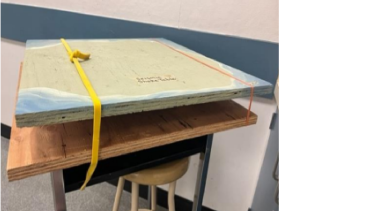
NFTN- Earthquake Building Design, October 13th
Spotlight on Learning: Earthquake Building Design
Presented by: Mike Perry
Earth Science 11
TEACHER DESCRIPTION/ REFLECTION: In this Lab, students were asked to brainstorm, design, and eventually build a 2-storey apartment building that would capably withstand varying degrees of earthquake shaking on a constructed earthquake shake table. In this lab, students were all given the exact same materials (paper plates, popsicle sticks, tape, and string) to create fairness within the activity. To qualify for the test, students needed to satisfy the required building height (2-storeys) and popsicle length. Students were assessed based on their design ideas, their application of knowledge from unit material to lab activity, and their ability to withstand “earthquake” shaking when weights were incrementally added to their structure. I was very surprised by who found success with this lab and how much engagement students demonstrated in this activity. I think students appreciated the flexibility they were given with their designs, but they appreciated the structure of the height and weight restrictions imposed. Although students used popsicle sticks and plates to complete this lab, there was real-world crossover when students made comments about their building being strong because of certain design elements integrated. It was also observed that certain students were very good at rationing their supplies while others used theirs up quickly and needed additional resources. Conversations around budget were had with students in order to ensure they understood the importance of conservation and profitability.
STUDENT REFLECTION: “In this activity I was given a choice of how I wanted to design my earthquake-resistant building. I liked being able to work with my friends and with my hands and apply what I learned in class to this lab activity. I was surprised how hard this activity was when I started to plan and design. I also recognized how important it is to have a plan and how it is important to make good use my supplies because I only got what I was given. I learned from my classmates after seeing what designs worked well and which designs did not work well when tested. I learned a lot from this lab because it gave me some real-world examples of how if buildings are not built properly, they will collapse quickly with limited shaking. I also enjoyed watching other people’s structures fail when they rushed through their design and building stages.”